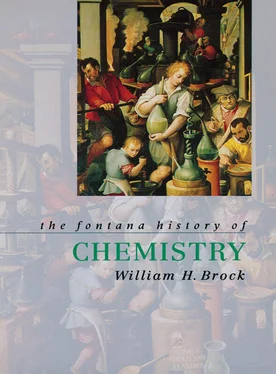Nature was a perpetual worker; all things, he wrote in the Opticks , grow out of, and return by putrefaction into, water.
Nevertheless, Newton subscribed wholeheartedly to Boyle’s corpuscular philosophy, to which he added the mechanisms of attraction and repulsion to explain not merely the gravitational phenomena of bulk planetary matter, but also the chemical likes (affinities) and dislikes (repulsions) that individual substances displayed towards one another. Such inherent powers of matter, which Newton attributed to a subtle ether that bathed the universe, replaced the astral influences of Paracelsus and the blas of Helmont as the causes of motion and change. Newton made this the subject of his only published chemical paper, ‘De natura acidorium’, written in 1692 but not published until 1710, as well as the ‘Queries’ 31 and 32 of the 1717 edition of the Opticks. In these writings Newton suggested that there were exceedingly strong attractive powers between the particles of bodies, which extended, however, only a short distance from them and varied in strength from one chemical species to another. This hypothesis of short-range force led him to speculate about what eighteenth-century chemists called ‘elective affinities’ and the reason why, for example, metals replaced one another in acid solutions. He gave the replacement order of six common metals in nitric acid.
The investigation of chemical affinity became one of the absorbing problems of chemistry. In 1718, Étienne Geoffroy (1672–1731) produced the first table of affinities, and more elaborate ones were produced by Torbern Bergman (1735–84) and others from the 1750s onwards. As the Newtonian world picture grew in prestige, chemists and natural philosophers also began to interpret these tables in terms of short-range attractions. In 1785 Buffon even identified the laws of affinity with gravitational attraction; but all attempts to satisfy what has been described as the ‘Newtonian dream’ to mathematize (i.e. quantify) affinity ended in failure. It was left to Claude Berthollet to point out in 1803 that other factors, such as mass (concentration), temperature and pressure, also decided whether or not a particular reaction was possible.
Newton’s ether, the active principle of chemical change, was exploited by large numbers of eighteenth-century chemists, including the important Dutch teacher, Hermann Boerhaave (1668–1738). The latter’s Elementa Chemiae (1732), which appeared in English in 1741, assimilated ether to fire. Fire, said Boerhaave, consisted of subtle, immutable bodies that were capable of insinuating themselves into the pores of bodies; it was ‘the great changer of all things in the universe, while itself remaining unchanged’. Like his German contemporary Georg Stahl, whose work he ignored, Boerhaave treated fire, together with the other three Aristotelian elements, as one of the four ‘physical instruments’ available to chemists. Because of the connections that were established between the Scottish universities and the University of Leiden, where Boerhaave taught, Boerhaave came to have considerable influence on the teaching of chemistry to medical students in Scotland by William Cullen (1710–90) and his pupil, Joseph Black (1728–99).
Cullen, for example, explained chemical attraction as due to the self-repulsive character of the particles of etherial fire and to the relative densities of ether within two attracting bodies compared with the density of ether in the external environment. The solid and liquid states similarly depended upon the relative quantities of ether and ordinary matter within a substance – a model that was to have important consequences for the conceptualization of gases. This identification of ether and fire, or heat, stimulated Cullen’s pupil, Joseph Black, to the study of calorimetry, the establishment of the concepts of specific heat capacity and latent heat, and the exploration of the qualitative difference between air and a ‘fixed air’ (carbon dioxide), whose presence in magnesia alba (basic magnesium carbonate) he had deduced in 1766.
Newton was also the inspiration behind the experimentally deft attempts made by Stephen Hales (1677–1761) to discover the mechanism of plant growth through an investigation of the movement of sap. It was while making these investigations in the 1720s that he discovered that plants and minerals contained, or held within their pores, large quantities of air. In his Vegetable Staticks published in 1727, Hales devoted over a third of the book to a demonstration of this finding, which he proved by heating solids and liquids in a gun barrel and collecting the ejected air over water in a vessel suspended from a beam. This discovery that air could be ‘fixed’ was the beginning of pneumatic chemistry, and a key factor in the eighteenth-century ‘chemical revolution’.
By rejecting the claim that the ultimate elements could ever be identified by fire analysis alone, and by arguing that whatever was released by fire were not elements but classes of substances, Boyle failed to be helpful to the practical chemist. The result was that practical chemists went back to the elements. But with one difference. They now began to separate physical from chemical theories of matter and to accept that, to all intents and purposes, substances that could not be further refined by fire or some other method of analytical separation were effectively chemical elements. This did not preclude the possibility that these ‘elements’ were composed from smaller physical units of matter, but this was a possibility that the investigative chemists could ignore. Such a pragmatic attitude was to reach its final form in Lavoisier’s definition of the element in 1789. We find a good example of this attitude in the theory of elements advocated by Georg Stahl (1660–1734), which is customarily referred to as the phlogiston theory. This in turn had been developed from the writings of Becher.
The severe economic problems of the several small and scattered states and principalities that made up the Holy Roman Empire had encouraged rulers to surround themselves with advisors and experts. As we have seen, this was one of the reasons why alchemists were often to be found at European courts, as were ‘projectors’ and inventors of various kinds. With the growth of government and civil service, the Germanies developed a tradition of cameralism (economics), which strove to make their countries self-sufficient through the strict control of the domestic economy and the efficient exploitation of raw materials and industry. It was the problems connected with mining and with glass, textile, ceramic, beer and wine manufacturing that encouraged the German states to take chemistry seriously. By the beginning of the eighteenth century, chemistry was to be found in many German universities in both the contexts of medicine and cameralism.
Johann Becher (1635–82?) was an early cameralist. With the backing of the Austrian emperor, Leopold I, he founded a technical school in Vienna in 1676 for the encouragement of trade and manufacture. Some years later he moved to the Netherlands to try to launch a scheme for recovering gold from silver by means of sea sand, and he is reputed to have died in London after investigating Cornish mining techniques. Becher wrote of himself in his most important book, Physica Subterranea (1667), that he was 4 :
… One to whom neither a gorgious home, nor security of occupation, nor fame, nor health appeals to me; for me rather my chemicals amid the smoke, soot and flame of coals blown by bellows. Stronger than Hercules, I work forever in an Augean stable, blind almost from the furnace glare, my breathing (sic) affected by the vapour of mercury. I am another Mithridates saturated with poison. Deprived of the esteem and company of others, a beggar in things material, in things of the mind I am Croesus. Yet among all these evils I seem to live so happily that I would die rather than change places with a Persian king.
Читать дальше












